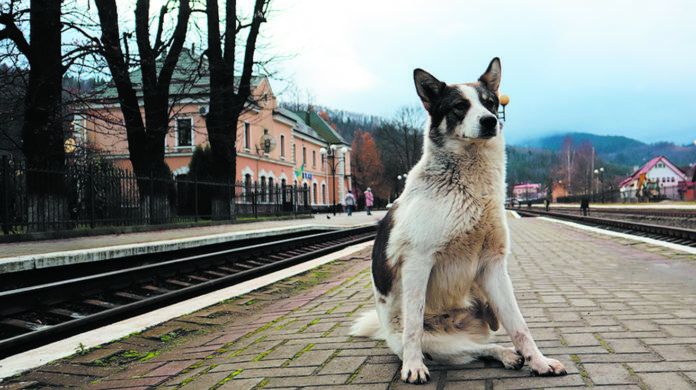As a dog lover, you’ve no doubt experienced that tug on your heart — and your conscience — when you’ve spotted a dog roaming the streets, running around a parking lot, or wandering alongside a busy strip small. But perhaps you’ve kept walking or driven by because a) there was too much traffic to stop and get to the dog before it moved on; b) you were afraid the dog would be aggressive and bite; or c) you didn’t really know how you could help, even if you could coax the animal to come to you.
You don’t have to waffle between your conscience and your actions anymore. With the right strategy in place, you’re in a good position to help a homeless dog you encounter. And by “help” we don’t just mean feeding an animal and moving it away from traffic. Each year, more than 600,000 dogs brought to shelters as strays are returned to their owners, reports the American Society for the Prevention of Cruelty to Animals (ASPCA). Many more are adopted into new homes. And lots of dogs found on the street never even have to reach a shelter. They are wearing ID tags and have dispositions calm enough for a stranger to gain their trust and return them to their human family without using a shelter or animal rescue as a go-between.
Here’s what you need to know to effectively get a dog off the street and give him a chance to be reunited with the people who have always taken care of him — or be matched with new people who will love him for the rest of his life.
Keep the following items in your car
To always be at the ready, stock your trunk with the following:
- A tasty, easy-to-smell treat like dried liver to lure a dog to you and perhaps win his trust.
- An animal first-aid kit in case the dog is injured.
- Bottled water and a bowl to put it in.
- A blanket for warming or for the dog to rest on.
- An extra leash and collar.
Also be prepared to call the animal control officer or the police station — or the local shelter — of the area in which you find the dog. These things are quick and easy to find on your cell phone.
How to approach
Never, ever chase the dog. That will only send a potentially scared dog in the opposite direction, and a dog can definitely outrun you. Even a small one can run about 15 miles an hour. Instead, try to coax the animal to come to you. Some dogs will come readily. For others, you may have to put the water in the bowl, toss the treat, and take it from there. Make soft clicking or kissing noises so the dog knows you come in peace. Also, avoid making direct eye contact, and don’t move in a hurried fashion.
It’s best if your reassuring manner coaxes the dog to come to you rather than the other way around. That means you’ve earned a modicum of trust, and he might be more cooperative. You’ll be able to get near his neck so you can tug a bit on his collar and read his identifying information.
In the best-case scenario, the dog will hop in your car and you can take him back to the address on his collar or to the local shelter (where a microchip might be found beneath his skin with all his contact information). But if you’re not able to convince the dog to jump into your vehicle, or if you have any sense that his fear or disorientation will make him aggressive and possibly bite you, it’s best not to get too close. Instead, call one of the resources recommended above. Then keep an eye on the dog as best you can until a properly trained official arrives.
Bear in mind that if you’ve parked your car at a busy intersection or perhaps by the side of a highway (homeless dogs do not necessarily pick convenient spots), you should have your hazard lights blinking the whole time so other drivers know you are staying put. You don’t want your efforts to save a dog to cause an accident.
A stray dog is one who had a home but got away or was abandoned. Either way, he knows what it is like to be with people but has “strayed away.” A feral dog, on the other hand, is unsocialized to people (and might be more apt not to trust people as well as to lack vaccinations against organisms that can cause serious diseases). “There are not that many feral dogs in the U.S., especially in the Northeast,” says Emily McCobb, DVM, Director of Shelter and Community Medicine at Tufts’s Cummings School of Veterinary Medicine. Feral is a more of a cat thing.
There are about 70 million stray animals in the United States (dogs and cats combined). Of those, only about 10 percent make their way to animal shelters, in no small part because of the selflessness of Good Samaritans who go out of their way to help get homeless animals off the streets. Of that 10 percent, only about one in 10 have been spayed or neutered. That’s particularly unfortunate. An unspayed dog and her offspring can create 67,000 new dogs in just seven years, according to one estimate. And many of them are eventually euthanized because there are not enough people to adopt them, their only “crime” having been born. That’s why it is critical to spay and neuter dogs unless you are a professional breeder who takes very good care of the new puppies in your home and then adopts them out to families that have been screened to make sure they will be a good fit and will also take good care of them.






Re. OGCARE
Helping a Dog You Find On the Street:
1. If you are in a quiet neighborhood, know that the dog knows where he lives and will probably find his way home without help. This doesn’t mean you should not try and get a hold of the dog.
2. A lot of dogs are wary of people who try and grab them by the collar. You need to be stealthy about this.
3. A lot of dogs are wary of strangers who try and coaks them near. That could send them into a run. And some dogs are not food driven. My best strategy is to lie on the ground and let them come sniff me out of curiosity. Don’t spring into action when they approach either. That will spook them.
4. If you have a dog that can be a great lure.
Your article assumes a would-be helper in a car, with the supplies you mentioned stored in the trunk. A likelier situation where I live is that the would-be helper is a pedestrian (with or without a dog) who will not have treats, blankets, water bowl, and so forth at hand. Advice for dealing with that situation would be helpful.
If I am walking my own dog or my clients’ dogs I am pretty wary of approaching a stranger. A couple of times it was obvious it wouldn’t be a problem, but my first responsibility is the safety of my own or my clients’ pups. My sheltie has been attacked several times so I am wary…